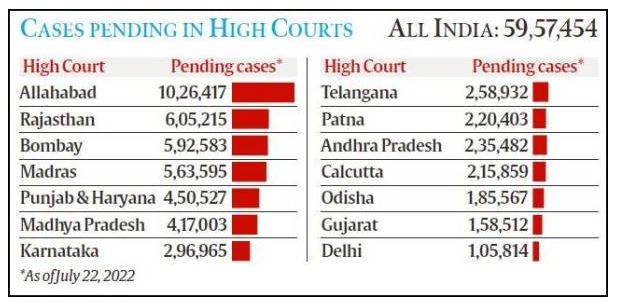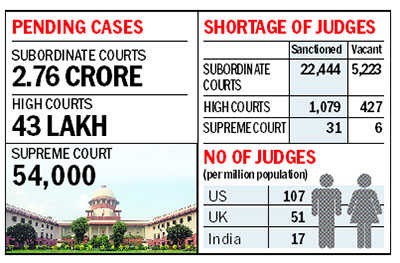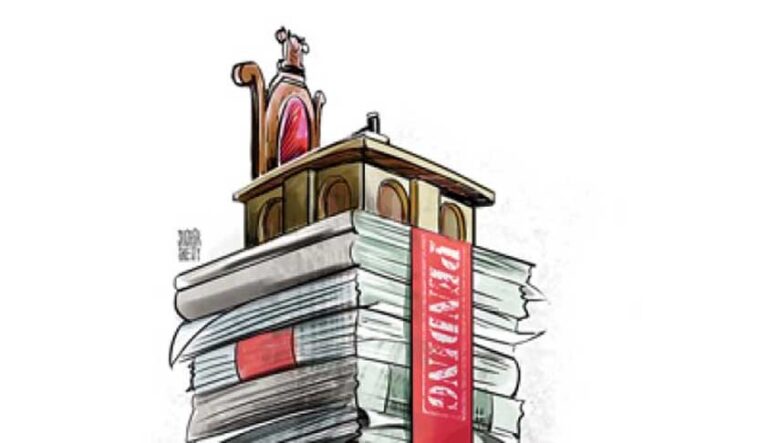Introduction
The Indian judiciary, often referred to as the “last bastion of hope” for citizens seeking justice, has long grappled with a significant issue: the alarming backlog of pending cases. This problem of case pendency in India has been a subject of concern for decades, with its roots deeply embedded in the complexities of the legal system, resource constraints, and procedural delays. In this article, we will explore the causes and consequences of case pendency in India’s judiciary and examine some potential solutions.
The Magnitude of the Problem

The issue of case pendency in India is staggering in its scale. According to the National Judicial Data Grid (NJDG) as Over 5.02 crore cases are pending in various courts across India, India Law Minister Arjun Ram Meghwal also confirmed this data.This backlog includes cases in the Supreme Court, High Courts, and subordinate courts, highlighting the widespread nature of the problem.
Causes of Case Pendency

Shortage of Judges -: One of the primary factors contributing to case pendency is the acute shortage of judges at all levels of the judiciary. India has one of the lowest judge-to-population ratios in the world, with a significant number of vacancies in various courts.
Procedural Delays -: The Indian legal system is notorious for its complex procedures and delays. Frequent adjournments, lengthy court processes, and bureaucratic red tape often lead to cases dragging on for years.
Inadequate Infrastructure -: Many courts in India lack the necessary infrastructure and technological advancements to efficiently manage cases. This leads to inefficiencies in record-keeping, scheduling, and communication.
Lack of Alternative Dispute Resolution Mechanisms -: Encouraging alternative dispute resolution mechanisms, such as mediation and arbitration, can help relieve the burden on the judiciary. However, these methods are not widely adopted.
Increased Litigation -: A growing awareness of legal rights and an increase in litigation have added to the caseload of Indian courts. This is a positive development in terms of access to justice, but it also exacerbates the problem of case pendency.
Consequences of Case Pendency
Delayed Justice.-: The most significant consequence of case pendency is the delay in the delivery of justice. Cases often drag on for years, causing frustration and suffering for litigants.
Loss of Faith in the Legal System :-Prolonged legal battles erode public trust in the judicial system. Many individuals and businesses opt for out-of-court settlements due to the perceived inefficiency of the courts.
Economic Impact -: The economic consequences of case pendency are substantial. Businesses suffer from delayed commercial disputes, leading to financial losses and a lack of confidence in India’s business environment.
Criminal Justice Delays -: The delays in criminal cases can result in prolonged incarceration of undertrial prisoners, violating their fundamental rights and causing overcrowding in prisons.
Backlog of Important Cases -: Critical cases related to constitutional matters, human rights, and public interest often take a backseat due to the overwhelming number of pending cases.
Potential Solutions

“A Bloomberg Businessweek estimate states, “If the nation’s judges nonstop battled their backlog — with no breaks to eat or sleep — and closed 100 cases per hour, it will take more than 35 years to
Time Bound Trials
- The Concept of Time Frame should be followed, and the Judiciary should prepare a time frame, for the disposal of cases
- The Process should not be a Hurdle
- The court process should not be a hurdle for the people. A vision of equal, expeditious and inexpensive justice for India’s millions, a passion for the effective delivery of social justice for the victims and a mission of constitutional fulfilment through a dynamic rule of law geared to democratic values
- Collegium System and Judges’ Appointment
- To maintain transparency, the selection of the High Court judges should be through a transparent and public mechanism so that the right candidate can be chosen to sit in the constitutional courts. No nepotism or favouritism!
- Live- Hearings of the PIL
- PIL refers to litigation undertaken to secure public interest and demonstrates the availability of justice to socially disadvantaged parties.
- Individuals with hidden agendas having unscrupulously filed a PIL of dubious nature can only be safeguarded by the live streaming of PIL.
- The Establishment of New Courts
- This is a fact that the non-availability of judges, delays the process of justice courts, so some new courts should be made in District courts for fast disposal of the cases.
- The Massive need for Reforms in Revenue Courts
- Revenue courts are specifically dealing with matters related to land revenue where the sufferers are poor farmers. So, to regulate them, the state should provide these with proper resources and infrastructure so that they can work effectively and efficiently.
- The Appointed Senior Advocates
- Advocates who are designated as Senior Advocates should contest at least 20% of the cases pro bono for needy and poor people. A list should be made by State Legal Authority; mentioning the names of advocates and cases should be provided to them.
- Modernization of Courts i.e., Virtual Courts Courts
- The Corona period triggered the Indian Judiciary to embrace a more present-day working procedure. The courts are becoming virtual, with cases and hearings occurring over virtual conferences.
- Soon, the courts should be permanently converted into Virtual Mode as it will prove to be very beneficial in decreasing corruption and in saving the expenses caused in Courts. It will be massively helpful to those who are distant. Saves time, effort and money.
Case management- India is famed for issuing adjournments and encouraging parties to manipulate judicial delays. This can be addressed by modifying legal rules to restrict the number of circumstances that adjournments are granted.
- Modifying the evidence and the procedures of the court and reducing the number of delays, continuations and adjournments permitted by the court can help in management.
- To ensure adherence, the timeline for the completion of the case requires a clear set of penalties, especially for the party deviating from the timeline.
- The data or records of each judge for the disposal of cases should be made public and ideally incorporated in decisions to raise judges to a higher bench.
- Faster trial
- The Law Commission has consistently recommended hearing cases, avoiding postponements and arriving at speedy verdicts.
- That is only possible if the case-load per judge is sufficient. It will be a big move forward to create an Indian Judiciary Service and create a wide pool of qualified, committed judges that will increase the pool of talent available for promotion to the higher court.
- Innovative approaches such as developing new courts of appeal, exploring IT technologies that can simplify workflows, constructing improved facilities that enable access to courtrooms are some ways forward to chip away from the current backlog.
- saccess to courtrooms are some ways forward to chip away from the current backlog.
-
Delegating Administrative Functions
- Presently, the respective registries of the courts are mostly tasked with carrying out the judiciary’s administrative functions. This structure has limited the potential for professionalizing these ranks and building up expertise.
- Many other countries have accepted that the administrative functions of courts and tribunals should be supported by a separate professional agencywith administrative expertise, specialization, and modern management practices and technologies.
- For example, in United States, the Administrative Office of the U.S. Courts(a specialized agency established in 1939 within the judicial branch) provides a broad range of legislative, legal, financial, technology, management, administrative, and program support services to federal courts.
- In March 2021, Chief Justice N. V. Ramana has clearly articulated the idea of a National Judicial Infrastructure Corporation, thereby focusing on the judiciary’s administrative functions.
-
ADR
- The government, being the largest litigant should self-motivate itself to use alternate dispute redressal system and approach the courts only as a matter of last resort.
- The Law Commission has consistently recommended hearing cases, avoiding postponements and arriving at speedy verdicts.
- That is only possible if the case-load per judge is sufficient. It will be a big move forward to create an Indian Judiciary Service and create a wide pool of qualified, committed judges that will increase the pool of talent available for promotion to the higher court.
- Innovative approaches such as developing new courts of appeal, exploring IT technologies that can simplify workflows, constructing improved facilities that enable access to courtrooms are some ways forward to chip away from the current backlog.
-
The 221st Report of the Law Commission
- The 221st report presented by the Law Commission in April 2009 was titled “The Need for Speedy Justice- Some Suggestions.”
- The report was formed taking into account the huge arrears of cases, specifically in High Courts and District Courts.
- It was stated in the report that huge pendency is a cause of great concern not only for the litigants but for the State as well. The report read as “It is a fundamental right of every citizen to get speedy justice and speedy trial which also is the fundamental requirement of good judicial administration.”
-
The 230th Report of the Law Commission:
- The presentation of the 230th Report of the Law Commission was done in August 2009. The report was titled “Reforms in the judiciary – Some suggestions.” The report suggested that there is a need to bring about radical changes in the formation and functioning of the High Courts in India.
- This will enable the citizens to have fair and speedy justice and will increase their faith in the justice delivery system. The report stressed that under our Constitution, the post of judge holds a significant place. The incumbent mustn’t be just fair, independent, and unbiased but also intelligent and diligent.
- Further, the committee suggested that the strength of judges be increased and new benches of High Courts should be created.
- Moreover, the committee focused on increasing the number of working days and keeping a check on the vacations enjoyed by the Courts.
Conclusion
“Justice delayed is justice denied” is a common aphorism that is often cited while talking about the pendency of cases and jurists note that the achievement of some of the fundamental aims of the Indian Constitution is frustrated by the mounting backlog of cases.”
• To start reducing its judicial case backlog, India needs a strategy that focuses on both the immediate problems facing its judiciary and their root causes. The Government should address the institutional weaknesses.
• There is a need of collective effort between legislature, executive and judicial system.
• The spending on research for justice delivery and legal reforms remained low, We need to spend more on judicial infrastructure.
• A political will and an earnest desire for radical change is a must.
• Right to justice itself being a fundamental right under the Indian Constitution is everyone’s mandate and the State and the courts must do their bit to ensure that a citizen’s tryst with justice meets with justice. It is a larger quest whether a litigant mired in pendency conundrum can ever be rendered complete justice.
The issue of case pendency in the Indian judiciary is a complex and multifaceted challenge that requires concerted efforts from all stakeholders, including the government, the legal community, and the citizens. While the road ahead is undoubtedly challenging, addressing this issue is essential to uphold the rule of law and ensure timely access to justice for all in the world’s largest democracy.

